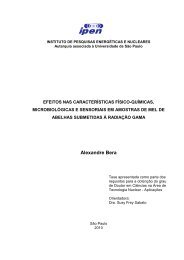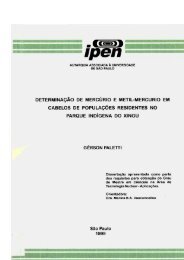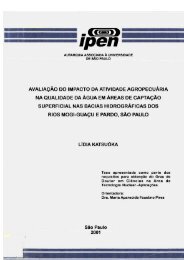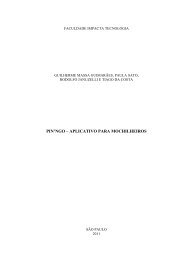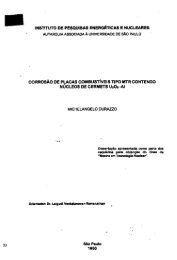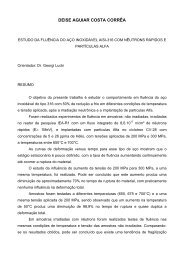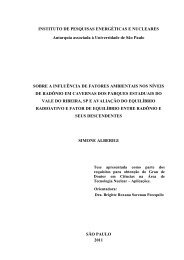Absorbed dose enhancement caused by gold particles in polymer gelsL.C. Afonso, F. Schöfer and C. HoeschenInstitute of Radiation Protection, Helmholtz Zentrum, Munich, GermanyAbstract— Previous studies showed that the presence ofhigh-Z materials adjacent to soft tissues, when submitted toirradiation, enhances the absorbed dose in these tissues. Thiseffect is due to the outscattering of photoelectrons from thehigh-Z materials. The aim of the present work was to measurethe absorbed dose enhancement caused by the presence ofdifferent concentrations of gold particles in polymeric gels.Keywords— polymer gel, three-dimensional dosimetry, NMR,gold particles.I. INTRODUCTIONIt is known from previous studies that the presence ofhigh-Z materials adjacent to soft tissues, when submitted toirradiation, enhances the absorbed dose in these soft tissues.This is due to the outscattering of photoelectrons from thehigh-Z materials. [1, 2]The concern about the effect of dose enhancement aroseafter discovering that oral cavity radiation therapy treatmentson patients that had golden tooth replacements resultedin an increased damage of the soft tissues surroundingthese gold replacements. It was found that the absorbeddose could reach an enhancement of two orders of magnitudein the microscope vicinity of gold replacements, whenexposing the patient to diagnostic X-ray examinations. [1]In experiments with human lymphocytes covered with athin gold film and then irradiated with diagnostic X-raybeams, it was found that the dose absorbed by the cells wasincreased by a factor of 45.4. The number of chromosomicaberrations was also in accordance to this dose enhancement.[2]Thereby, the aim of the present work was to measure theabsorbed dose enhancement caused by the presence of differentconcentrations of gold particles in polymeric gels,which the main characteristic is the soft tissue equivalence.The polymer gel dosimetry technique allows the absorbeddose to be measured with high three-dimensional resolution,which is essential to analyze the enhancement distributiondue to photoelectrons outscattered by the gold particles.A. Polymer gelII. DOSIMETRIC METHODPolymeric Systems began to be studied in relation totheir dosimetric capacity in the fifties, by evaluating theradiation effects in poly-methyl-methacrylate [3]; andstudying radio-induced polymerization in liquids [4]. Later,works combined these properties as the first polymer geldeveloped by Maryanski et al [5, 6], which had formulationthat was composed by acrylamide, bis-acrylamide and nitrousoxide diluted in an agarose aqueous matrix. The polymerizationreaction in this gel was based on the crosslinkingof acrylamide monomers.Further gel formulations were developed by changing thegel matrix (agarose to gelatin), the monomer (acrylamide tomethacrylic acid, for example), etc. However, the workingprinciple of any polymer gel dosimeter is based on the radiation-inducedpolymerization of the monomers present inthe gel. When the gel is irradiated, the water radiolysis isinduced. The polymerization process is mainly initiated byfree radical reactions. The polymerization degree dependson the number of free radicals created by the incident radiation,which depends on the absorbed dose; therefore, originatingspatial dose resolution. [7, 8]The polymer gel used for this work is known as MAGIC(Methacrylic Ascorbic in Gelatin Initiated by Copper),foremost developed by Fong et al [9]. Its formulation iscomposed by methacrylic acid, ascorbic acid, gelatin andcopper sulfate. As the gel polymerization process is initiatedby free radical reactions, and molecular oxygen is an efficient“scavenger” of free radicals, its presence inhibits gelpolymerization. Therefore, the ascorbic acid, in a processinitiated by the copper sulfate, is responsible for capturingoxygen in the gel solution.B. Nuclear Magnetic ResonanceNuclear Magnetic Resonance (NMR) is a technique thatallows determining the properties of a substance by correlatingthe absorbed energy and the frequency, in the radiofrequencyrange of the electromagnetic spectrum. The techniqueuses the transitions between the rotational energyO. Dössel and W.C. Schlegel (Eds.): WC 2009, IFMBE Proceedings 25/III, pp. 414–415, 2009.www.springerlink.com
Absorbed Dose Enhancement Caused by Gold Particles in Polymer Gels 415levels of the compound’s nucleus (atoms or ions) containedin the sample. This occurs necessarily under a magneticfield influence and under the concomitant irradiation withradiofrequency waves.In dosimetric gels, the scanning process is based on themeasurement of the longitudinal and the transversal relaxationrates (R1 and R2), from which dose maps may be determined.Traditionally, the corresponding relaxation times(T1 and T2) are measured, then, the rates are determined.The longitudinal relaxation time, T1, or spin-net relaxationtime, is associated with the interaction of the spins with thenet. The longitudinal relaxation is responsible for the returnof the magnetization to the thermal equilibrium state. Thetransversal relaxation time, T2, or spin-spin relaxation time,is associated to the interactions between the spins. Due tothe transversal relaxation, the magnetic moments lose coherence,which makes them precess with lightly differentfrequencies. The relaxation times are measured by applyingradiofrequency pulses to excite the magnetization of thespin system, and then, samples are collected during thereturn to equilibrium. The transversal relaxation time(T2=1/R2) is measured by adjusting the collected data ofthe transversal relaxation curve after excitation. [10, 11]III. METHODOLOGYThe samples of polymeric gels (30 ml flasks), with andwithout gold particles were irradiated with X-rays and rays beams. Then, these samples were scanned with a NuclearMagnetic Resonance system and the resultant transversalrelaxation rate (T2) distribution was analyzed andassociated to the absorbed dose.Further results are under analysis.REFERENCES1. Regulla D, Friedland W, Hieber L et al (2000) Spatially LimitedEffects of Dose and LET Enhancement Near Tissue/Gold Interfacesat Diagnostic X Ray Qualities. Radiation Protection Dosimetry, 90,Nos 1–2, pp. 159–1632. Regulla D, Panzer W, Schmid E et al (2001) Detection of ElevatedRBE in Human Lymphocytes Exposed to Secondary Electrons Releasedfrom X-Irradiated Metal Surfaces. Ratiation Research, 155, pp.744–7473. Alexander P, Charlesby A, Ross M (1954) The Degradation of SolidPolymethyl-methacrylate by Ionizing Radiations. Proceedings of theRoyal Society, pp. 392-4044. Hoecker FE, Watkins IW (1958) Radiation Polymerization Dosimetry.International Journal of Applied Radiation and Isotopes, 3,pp. 31-365. Maryanski MJ, Gore JC, Schulz RJ (1992) 3-D Radiation Dosimetryby MRI: Solvent Proton Relaxation Enhancement by Radiation-Controlled Polymerisation and Cross-Linking in Gels. Proc. Intl. Soc.Mag. Reson. Med.6. Maryanski MJ, Gore JC, Kennan RP et al (1993) NMR RelaxationEnhancement in Gels Polymerized and Cross-Linked by Ionizing Radiation:a New Approach to 3D Dosimetry by MRI. Magn. Reson.Imaging, 11, pp. 253-2587. Berg A, Ertl A, Moser E (2001) High Resolution Polymer Gel Dosimetryby Parameter Selective MR-Microimaging on a Whole BodyScanner at 3 T. Medical Physics, 28(5), pp. 833-8438. Bayreder C, Georg D, Moser E et al (2006) The spatial resolution indosimetry with normoxic polymer-gels investigated with the dosemodulation transfer approach. Medical Physics, 35(5), pp. 1756-17699. Fong PM, Keil DC, Does MD, Gore JC (2001) Polymer Gels forMagnetic Resonance Imaging of Radiation Dose Distributions atNormal Room Atmosphere. Physics in Medicine and Biology, 46, pp.3105-311310. Baustert IC, Oldham M, Smith TAD et al (2000) Optimized MRImaging for Polyacrylamide Gel Dosimetry. Physics in Medicine andBiology, 45, pp. 847-85811. McJury M, Oldham M, Cosgrove VP et al (2000) Radiation DosimetryUsing Polymer Gels: Methods and Applications. The BritishJournal of Radiology, 73, pp. 919-929Author: L. C. AfonsoInstitute: Helmholtz Zentrum MünchenStreet: Ingolstaedter Landstrasse 1City: NeuherbergCountry: GermanyEmail: Luciana.afonso@helmholtz-muenchen.deIFMBE Proceedings Vol. 25
- Page 1 and 2:
AUTARQUIA ASSOCIADA À UNIVERSIDADE
- Page 3 and 4:
AGRADECIMENTOSÀ Dra. Linda V. E. C
- Page 5 and 6:
STUDY OF THE INFLUENCE OF GOLD PART
- Page 7 and 8:
5.1.3 Dependência do Dosímetro em
- Page 9 and 10:
A resposta dos tecidos às radiaç
- Page 11 and 12:
1978), indicando que pode haver um
- Page 13 and 14:
delta (δ). Feixes contínuos de el
- Page 15 and 16:
da energia do fóton. Quando intera
- Page 17 and 18:
Figura 3.1 - Esquema de interação
- Page 19 and 20:
material atravessado. A Figura 3.2
- Page 21 and 22:
em que E b é a energia de ligaçã
- Page 23 and 24:
esultados experimentais, complement
- Page 25 and 26:
Já o processo de transição não
- Page 27 and 28:
K tr(Eq. 3.24)Outra grandeza impor
- Page 29 and 30:
comum. Este tipo de gel ficou conhe
- Page 31 and 32:
Estes radicais peróxido reagem rap
- Page 33 and 34:
submetidos ao mesmo campo magnétic
- Page 35 and 36:
t T1M zM01 e(Eq. 3.45) em que T
- Page 37 and 38:
3.4.4 Avaliação dos Dosímetros d
- Page 39 and 40:
3.5 Método de Monte CarloO método
- Page 41 and 42:
A probabilidade de obter um valor d
- Page 43 and 44:
método de Monte Carlo. Porém, par
- Page 45 and 46:
Tabela 4.1 - Especificações dos f
- Page 47 and 48:
- Sistema de Ressonância Magnétic
- Page 49 and 50:
5 METODOLOGIA E RESULTADOSNeste cap
- Page 51 and 52:
Os parâmetros TE (tempo de eco, in
- Page 53 and 54:
Figura 5.3 - Ajuste monoexponencial
- Page 55 and 56:
Tubo de raios XFiltrosCâmara monit
- Page 57 and 58:
IA = 1, 4 e 5 dias.Figura 5.8 - PI
- Page 59 and 60:
Figura 5.9 - Relação entre R 2 -R
- Page 61 and 62:
As amostras foram avaliadas 1 dia a
- Page 63 and 64:
As amostras foram avaliadas 1 dia a
- Page 65 and 66:
polimérico deveriam seguir uma dis
- Page 67 and 68: Coeficiente angularFigura 5.16 - Re
- Page 69 and 70: Coeficiente angularOs dados de cada
- Page 71 and 72: 5.2 Cálculo do Alcance de Elétron
- Page 73 and 74: 5.3 Experimentos Preliminares com F
- Page 75 and 76: Alguns estudos mencionam que o mate
- Page 77 and 78: sem ouro.Figura 5.24 - Relações e
- Page 79 and 80: 5.4 Feixes de Raios X que aumentam
- Page 81 and 82: Figura 5.28 - Espectro do feixe N-8
- Page 83 and 84: Figura 5.32 - Espectro do feixe N-2
- Page 85 and 86: Figura 5.34 - Espectros dos feixes
- Page 87 and 88: Tabela 5.4 - Composição detalhada
- Page 89 and 90: Figura 5.36 - Coeficiente de absor
- Page 91 and 92: para o tecido mole padrão da ICRP
- Page 93 and 94: 0,005 gAu/gGP apresenta um aumento
- Page 95 and 96: Fator de aumento de doseOs valores
- Page 97 and 98: Figura 5.45 - Distribuição da tax
- Page 99 and 100: Figura 5.47 - Relação entre a dos
- Page 101 and 102: Figura 5.49 - Aumento da dose absor
- Page 103 and 104: Figura 5.51 - Espectros dos feixes
- Page 105 and 106: R 2 - R 2 (0) (s -1 )Esta diferenç
- Page 107 and 108: R 2 - R 2 (0) (s -1 )com microesfer
- Page 109 and 110: Fator de aumento de doseprevisto, p
- Page 111 and 112: Os coeficientes de absorção máss
- Page 113 and 114: 7 REFERÊNCIASAFONSO, L.C.; SCHÖFE
- Page 115 and 116: MARYANSKI, M.J.; GORE, J.C.; KENNAN
- Page 117: Anexo: Trabalhos publicados em anai
- Page 121 and 122: IC3DDose 2010 - 6th International C
- Page 123 and 124: R2 (s -1 )IC3DDose 2010 - 6th Inter
- Page 125: DOSE SENSITIVITY ENHANCEMENT ON POL



